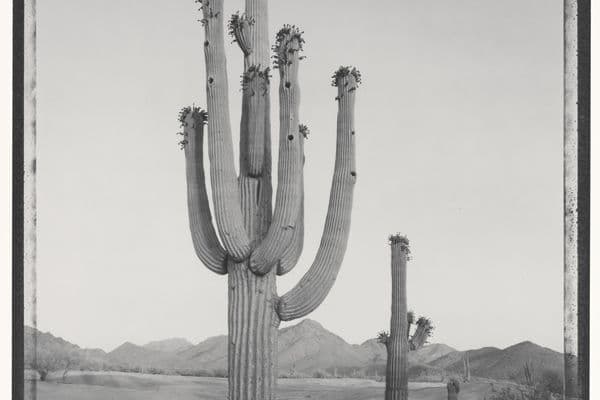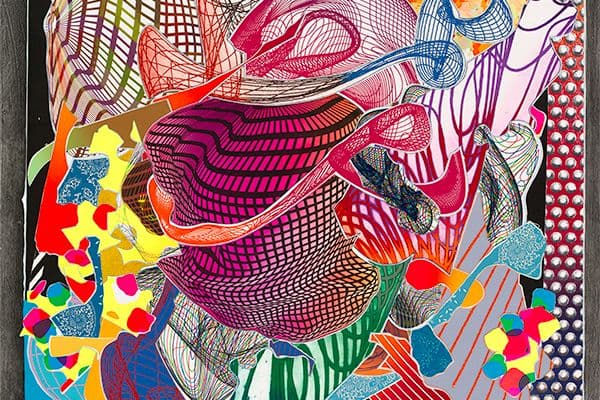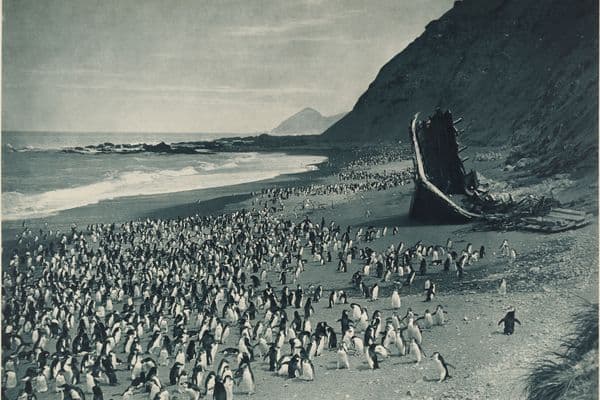The New Vision
A Revolution in Photographs 1920 – 1940
7 Feb 1987 – 7 Jun 1987

Albert Renger-Patzsch, Viper's head, 1925, National Gallery of Australia, Kamberri/Canberra, Purchased 1983.
About
The photographs in this exhibition, which are drawn from the permanent collection of the Australian National Gallery, were produced between two world wars. The period following World War One, 'the war to end all wars', was characterized by a great optimism that was widely expressed in the visual arts of the time. The success of the Russian Revolution and the possibility of a socialist revolution in Germany encouraged some people to believe that the arrival of a modern utopia was imminent. However, the events of the 1930s — above all, Adolf Hitler's rise to power and General Franco's overthrow of the Spanish Republic — dealt a blow to this optimism, and the declaration of World War Two in September 1939 ushered in a decade of destruction. As a result, many of the artists represented here were dislocated — in both physical and psychological terms — and fled Europe for England, the United States, Australia and elsewhere.
In keeping with the spirit and aims of radical politics, avant-garde artists of the 1920s, particularly those working in the USSR and Germany, developed new forms of expression appropriate to the modern age. Many artists were active in a variety of fields, photography among them: László Moholy-Nagy and Alexander Rodchenko, for example, were involved in poster-making and book design, and produced paintings and sculptures as well as photographs.
A Radical Medium
One of the most important photographic styles to develop during the 1920s is now termed 'the New Photography' or 'modernist photography', its corollary in painting being known as 'Neue Sachlichkeit' or 'New Objectivity'.
The hallmarks of the New Photography include the use of sharp focus, unusual vantage-points such as the extreme close-up or the up or down shot, and bold geometric compositions. These strategies were employed to disorient the viewer by altering his or her perceptions of familiar objects. The old, traditional way of seeing was ruptured, and the viewer was compelled to take an active role, not simply in relation to the photographic image, but to the real world in which he or she was encouraged to help build the new social order.
This concern with vision accounts for the recurring images of the human eye in the exhibition — there are single eyes, pairs of eyes, eyeglasses and masks.
The new photographers were thrilled by the products of the modern age, its tall buildings, its towers and bridges. Both Herbert Bayer and László Moholy-Nagy climbed a bridge at Marseilles, France, and took photographs looking down at the water and boats below. This new perspective, 'the bird's-eye' view, had its source in aerial photography, which first came into widespread use during World War One.
Other photographers experimented with radically framed images. The faces of Lucia Moholy’s subjects, for example Florence Henri, 1927, are not always enclosed by the photographic frame. Henri, who is represented in the exhibition by three of her own photographs, is pictured in disconcerting close-up with apparent disregard for the 'completeness' of the portrait. In Elizabeth, 1931, Paris, André Kertész similarly rejects convention and presents the face of his wife bisected by the framing edge.
August Sander also explored the impact of the New Photography on portraiture, using the style's apparent objectivity to document the full range of German society for his project 'Citizens of the Twentieth Century'. Sander was not concerned with individuals as such, but with the class of his sitters, who are always shown in relation to their environment.
Radical Photography Abroad
Photographers in other countries as well were involved in radical activities. In Mexico, with the conclusion of ten years of civil war in 1920, local artists and foreign visitors united to make their contribution to the Mexican Revolution. Tina Modotti, an Italian-born American, joined the Mexican Communist Party in 1927 and produced many photographs in support of the revolution. The objects in her still life were selected for their political significance: the sombrero, the hammer and the sickle were symbols of the Mexican workers' struggle for liberation. By contrast, Edward Weston chose toys (gourds carved by native Indians) for his still life Three fish — gourds, which was produced in Mexico in 1926. Manuel Alvarez Bravo's Striking worker, murdered, 1934, points to the violence that continued in Mexico into the 1930s.
Spain, too, became the site of a revolutionary struggle. Margaret Michaelis, who fled Germany for Barcelona in 1933 following Hitler's rise to power, was involved in documenting the living conditions of slum residents in Barcelona for a major redevelopment scheme inspired by the utopian belief in modern architecture. The project never came to fruition, however, due to the outbreak of the Spanish Civil War in 1936 and to General Franco's subsequent defeat of the Spanish Republic.
The utopian vision that inspired so many of the interwar photographers went hand-in-hand with the interest in developing new ways of seeing and representing the world. At the Bauhaus, initially in Weimar and then in Dessau in Germany, artists were committed to developing forms appropriate for the modern times — whether in architecture, furniture, book design, or other fields. On display in the present exhibition are a number of photographs produced by Bauhaus students such as Lotte Stam-Beese and T. Lux Feininger; all of these images reveal excitement and delight in the use of the camera.
Surrealists and the photomontage
While a teacher at the Bauhaus, László Moholy-Nagy, together with his wife Lucia Moholy, made a number of experiments with the photogram. A photogram is produced by placing objects on sensitized photographic paper, exposing the paper to light, and then developing it in the standard way. Moholy-Nagy saw photography as the medium of light, and his photograms are 'light drawings'. Many other artists made photograms, although for quite different reasons. The works published in Les Champs délicieux (1922) by Man Ray reflect an interest in the play of chance, made possible through the juxtaposition of essentially unrelated objects.
This notion of chance encounter was central to the Surrealist movement, a vital force during the 1920s and 1930s. The Surrealists also experimented with new ways of seeing, and produced elusive and suggestive images, such as those by Maurice Tabard and Jindrich Štyrský.
Another form of radical discontinuity that was developed in the 1920s was the photomontage. In John D. Rockefeller, 1926, Sasha Stone juxtaposes the face of the millionaire industrialist with a vast industrial landscape in order to make an obvious political statement: the landscape has been exploited for Rockefeller's profit.
Soviet photographer Alexander Rodchenko made an important group of photomontages in 1923 to illustrate Pro Eto [About This], a book of poems by his friend Vladimir Maiakovskii. Rodchenko did not take the photographs himself, but cut them up and assembled them in montage form. Many Russian revolutionary artists made books, as they were low in cost, relatively easy to produce, and could be widely circulated.1
John Heartfield's photomontages were similarly produced for publication, often as front or back covers to the anti-Nazi communist weekly Arbeiter Illustrierte Zeitung, or AIZ, of which the Gallery Library has a major collection. Heartfield's photomontages were for the most part constructed from familiar images — although images not normally associated with each other — and frequently included a phrase or slogan. While the artist's meaning is obvious, it is gained from the whole work, and not from its individual parts.
Moholy-Nagy's 'fotoplastiks' were also photomontages, but involved an element of drawing as well. The artist would arrange the photographs, execute the drawing and then re-photograph the work with the assistance of Lucia Moholy. A number of these 'fotoplastiks' were produced as advertisements.
New Photography outside of art
The New Photography was not always a weapon. Albert Renger-Patzsch, for example, photographed natural and man-made subjects for his book Die Welt ist Schön [The World is Beautiful], published in 1928. Taking the extreme vantage-points of the New Photography, Renger-Patzsch used the close-up in images such as Viper’s head, c.1925, and up and down angles in others. His aim was to demonstrate that the same structure underlay all objects, old or new, animate or inanimate, manufactured or natural.
In the United States, Edward Weston championed the new photographic realism. The two nude studies by Weston included here are in sharp focus, with the surface texture of the model's skin rendered in fine detail. Unlike Renger-Patzsch's prints, which were produced for publication in The World is Beautiful, Weston's images were made as objects in their own right.
During the 1920s the demand for photographers increased dramatically as a result of rapid industrialization and technological change. By the latter part of the decade, photographers were firmly established in two main areas: advertising and photojournalism. Hans Finsler and Josef Sudek were among the artists employed to illustrate the increasing numbers of manufactured objects — whether chocolates or china — available to consumers.2
The New Photography, with its immediacy and its authentic presentation of goods, was ideally suited to promotional material and provided the basis for modern advertising photography. The new-style advertisements were circulated in picture magazines, newspapers and trade catalogues throughout the late 1920s and 1930s. Widely disseminated, 'the look' was adopted by artists in Australia and elsewhere, who remained unaware of its original connection to radical ideology and utopian principles.
The advent of photojournalism was made possible through technological advances. The introduction of the light-weight Leica 35 mm camera in 1924 opened up a whole new range of possibilities to photographers, allowing them to work quickly, with a casualness and spontaneity impossible with more bulky equipment. Artists such as Felix H. Man became the first photojournalists, their human-interest images being reproduced in newspapers and in an ever-increasing variety of picture magazines.
New Photography amidst World War Two
The first international exhibition of the New Photography was Film und Foto, held in Stuttgart, Germany, in 1929. 'Fifo', as it came to be known, brought together the diverse uses of the medium, including images from both advertising and science. Moholy-Nagy organized an introductory gallery that charted the historical development of photography, and photographs from various fields were displayed alongside each other. This landmark exhibition marked the official acceptance of the New Photography.
The world was changing quickly. When Hitler came to power in Germany in 1933, large numbers fled the country. Leni Riefenstahl, who continued to work under the Third Reich, is represented here by three photographs of athletes participating in the Berlin Olympic Games of 1936. It is the body that holds Riefenstahl's interest — a body like a machine — perfect, finely tuned, physical.
It came as a rude awakening that the stylistic aspects of the New Photography could be brought into service by fascism as readily as by socialism. From the early 1930s onwards, many artists left Europe: László Moholy-Nagy, Gyorgy Kepes, André Kertész and others settled in the United States, where they picked up the threads of their careers and continued by teaching or by practising commercial photography; Margaret Michaelis and Wolfgang Sievers immigrated to Australia; others, like Sasha Stone and Yva, were less fortunate, losing their lives in Nazi concentration camps.
Over the last five years the Gallery has concentrated on acquiring European photographs from the inter-war period. As a result, this area is now one of the great strengths of the Photography collection.
Helen Ennis, Curator of Photography
1 The Gallery’s important collection of Russian books will be the subject of a future exhibition.
2 Fashion photography is not included here, as fashion photographs from the inter-war period, by artists such as George Hoyningen-Huene (1900-1968) and Edward Steichen (1879-1973), were recently featured in the Gallery’s exhibition The Glamour Show: Studio Photographs 1920-1955.











